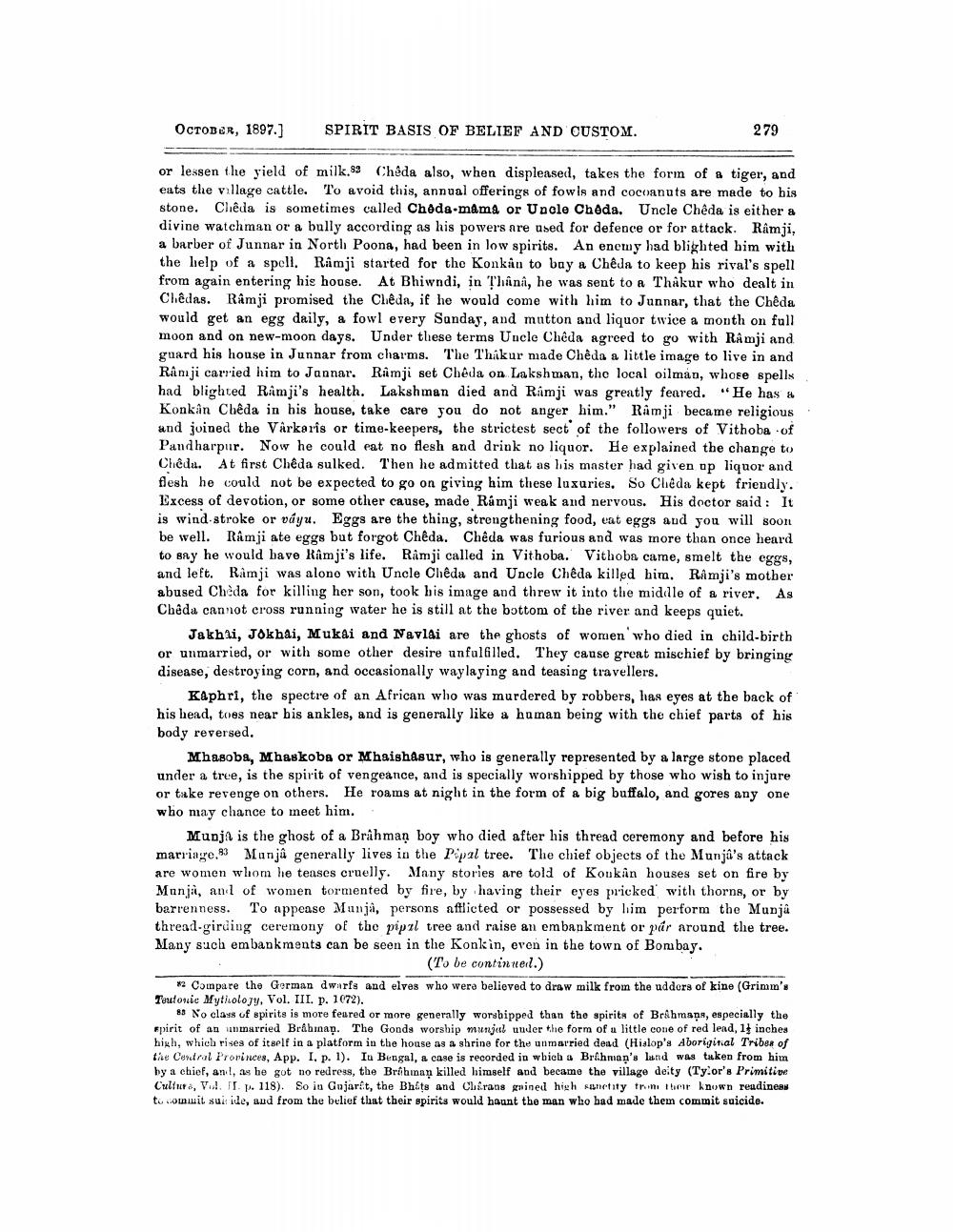________________
OCTOBER, 1897.]
SPIRIT BASIS OF BELIEF AND CUSTOM.
279
or lessen the yield of milk.82 Cheda also, when displeased, takes the form of a tiger, and eats the vallage cattle. To avoid this, annual offerings of fowls and cocoanuts are made to his stone. Chêda is sometimes called Choda-mama or Uncle Choda. Uncle Chêda is either a divine watchman or a bully according as his powers are used for defence or for attack. Ramji, a barber of Junnar in North Poona, had been in low spirits. An enemy had blighted him with the help of a spell. Rämji started for the Konkan to bay a Chêda to keep his rival's spell from again entering his house. At Bhiwndi, in Ihânî, he was sent to a Thakur who dealt in Chêdas. Ramji promised the Chiêda, if he would come with him to Junnar, that the Chêda would get an egg daily, a fowl every Sanday, and mutton and liquor twice a month on full moon and on new-moon days. Under these terms Uncle Cheda agreed to go with Ramji and guard his house in Junnar from charms. The Thikur made Chêda a little image to live in and Ramji carried him to Jannar. Rimji set Cheda on Lakshman, the local oilman, whose spells had blighted Ramji's health. Lakshman died and Ramji was greatly feared. "He has a Konkân Chêda in his house, take care you do not anger him." Ramji became religious and joined the Vårkoris or time-keepers, the strictest sect of the followers of Vithoba of Pandharpur. Now he could eat no flesh and drink no liquor. He explained the change to Chêda. At first Chêda sulked. Then he admitted that as his master had given up liquor and flesh he could not be expected to go on giving him these luxuries, So Chêda kept friendly. Excess of devotion, or some other cause, made Rámji weak and nervous. His doctor said : It is wind stroke or váyu. Eggs are the thing, strengthening food, eat eggs and you will soon be well. Ramji ate eggs but forgot Chêda. Chêda was furious and was more than once heard to say he would have Ramji's life. Ramji called in Vithoba. Vithoba came, smelt the eggs, and left. Ramji was alono with Uncle Chêda and Uncle Chêda killed him. Ramji's mother abused Cheda for killing her son, took his image and threw it into the middle of a river. As Chêda cannot cross running water he is still at the bottom of the river and keeps quiet.
Jakhri, Jokhai, Mukai and Navlai are the ghosts of women who died in child-birth or unmarried, or with some other desire unfulfilled. They cause great mischief by bringing disease, destroying corn, and occasionally waylaying and teasing travellers.
Kaphri, the spectre of an African who was murdered by robbers, has eyes at the back of his head, toes near bis ankles, and is generally like a human being with the chief parts of his body reversed.
Mhasoba, Mhaskoba or Mhaishasur, who is generally represented by a large stone placed under a tree, is the spirit of vengeance, and is specially worshipped by those who wish to injure or take revenge on others. He roams at night in the form of a big buffalo, and gores any one who may chance to meet him.
Munja is the ghost of a Brahman boy who died after his thread ceremony and before his marriage.83 Manja generally lives in the Pipal tree. The chief objects of the Munja's attack are women whom he teases cruelly. Many stories are told of Koukan houses set on fire by Monja, and of women tormented by fire, by having their eyes picked with thorns, or by barrenness. To appease Munja, persons aftlicted or possessed by lim perform the Munja thread.girding ceremony of the pipıl tree and raise an embankment or por around the tree. Many such embankments can be seen in the Konkin, even in the town of Bombay.
(To be contin neil.) 2 Compare the German dwarfs and elves who were believed to draw milk from the udders of kine (Grimm's Teutonic Myti.ology, Vol. III. p. 1072).
8 No class of spirits is more feared or more generally worshipped than the spirits of Brahmana, especially the fpirit of an unmarried Bribmap. The Gonds worship munjul under the form of a little cone of red lead, 14 inches high, which rises of itself in a platform in the house as a shrine for the unmarried dead (Hislop's Aboriginal Triber of the Cendral Prorinces, App. I. p. 1). Iu Bengal, a case is recorded in wbieb a Brahman's land was taken from him by a chief, and, as he got no redress, the Brihinan killed himself and became the village deity (Ty.or's Primitive Cultura, V... TI p. 118). So in Gujarat, the Bhéts and Cherans grained high abnetty train their known readiness tu sommit suit ide, and from the belief that their spirits would haunt the man who had made them commit suicide.




